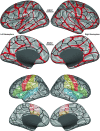Functional Parcellation of the Speech Production Cortex
- PMID: 31465713
- PMCID: PMC6813033
- DOI: 10.1044/2019_JSLHR-S-CSMC7-18-0442
Functional Parcellation of the Speech Production Cortex
Abstract
Neuroimaging has revealed a core network of cortical regions that contribute to speech production, but the functional organization of this network remains poorly understood. Purpose We describe efforts to identify reliable boundaries around functionally homogenous regions within the cortical speech motor control network in order to improve the sensitivity of functional magnetic resonance imaging (fMRI) analyses of speech production and thus improve our understanding of the functional organization of speech production in the brain. Method We used a bottom-up, data-driven approach by pooling data from 12 previously conducted fMRI studies of speech production involving the production of monosyllabic and bisyllabic words and pseudowords that ranged from single vowels and consonant-vowel pairs to short sentences (163 scanning sessions, 136 unique participants, 39 different speech conditions). After preprocessing all data through the same pipeline and registering individual contrast maps to a common surface space, hierarchical clustering was applied to contrast maps randomly sampled from the pooled data set in order to identify consistent functional boundaries across subjects and tasks. Boundary completion was achieved by applying adaptive smoothing and watershed segmentation to the thresholded population-level boundary map. Hierarchical clustering was applied to the mean within-functional region of interest (fROI) response to identify networks of fROIs that respond similarly during speech. Results We identified highly reliable functional boundaries across the cortical areas involved in speech production. Boundary completion resulted in 117 fROIs in the left hemisphere and 109 in the right hemisphere. Clustering of the mean within-fROI response revealed a core sensorimotor network flanked by a speech motor planning network. The majority of the left inferior frontal gyrus clustered with the visual word form area and brain regions (e.g., anterior insula, dorsal anterior cingulate) associated with detecting salient sensory inputs and choosing the appropriate action. Conclusion The fROIs provide insight into the organization of the speech production network and a valuable tool for studying speech production in the brain by improving within-group and between-groups comparisons of speech-related brain activity. Supplemental Material https://doi.org/10.23641/asha.9402674.
Figures





References
-
- Beal D. S., Segawa J. A., Tourville J. A., Cai S., & Guenther F. H. (2012). Speech motor sequence learning difficulties in persistent developmental stuttering: An fMRI study (Program No. 681.0). Meeting Planner, 42nd Annual Meeting of the Society for Neuroscience, New Orleans, LA.
-
- Benjamini Y., & Hochberg Y. (1995). Controlling the false discovery rate: A practical and powerful approach to multiple testing. Journal of the Royal Statistical Society. Series B (Methodological), 57, 289–300.
-
- Bohland J. W., & Guenther F. H. (2006). An fMRI investigation of syllable sequence production. NeuroImage, 32(2), 821–841. - PubMed
Publication types
MeSH terms
Grants and funding
LinkOut - more resources
Full Text Sources

